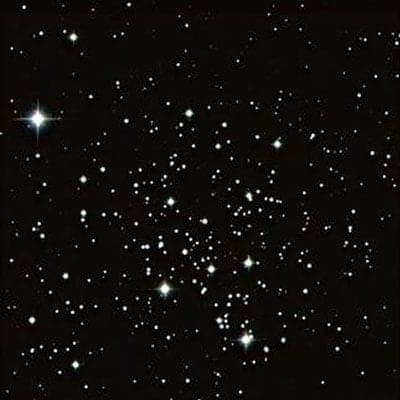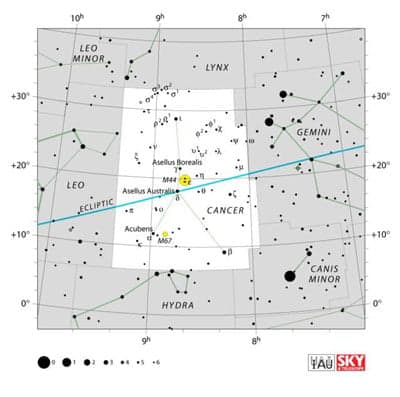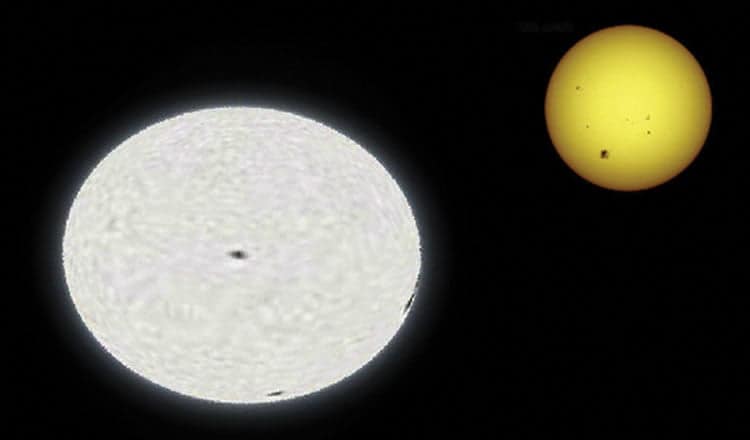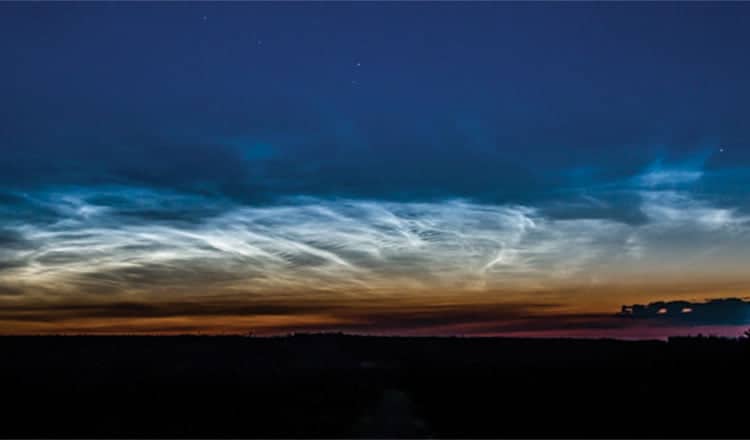What the constellation Cancer lacks in bright stars, it makes up for with its special deep sky resident, the Beehive open star cluster, or M44 in the Messier catalogue. At less than 600 light years (ly), the Beehive is one of our nearest open clusters. So with its 1,000+ stellar members, swarming in a 22.8 ly sphere, the Beehive emits a soft glow covering a full one and a half degree of sky, three times the diameter of the full moon.
Cancer is also home to another deep sky resident that presents an intriguing contrast to our flamboyant Beehive neighbour. The open cluster M67 is ten times further away, at almost 6,000 ly. And with only half the stars of the Beehive within a slightly smaller diameter, M67 presents a good challenge for viewing with binoculars, alongside the bedazzling, visible-to-the-naked-eye, Beehive. And precisely because of the bedazzlement of the Beehive upon the night sky, it has been noted by stargazers throughout the ages. In 260 B.C., the Greek poet and philosopher Aratus first made mention of it as “a faint mist” in a poem called “Phenomena,” at a time when the cluster was referred to as the Manger.
The two stars Asellus Borealis and Asellus Australis, above and below the Manger (see chart), became donkeys, coming to the Manger to feed. (You see the robustness of imagination without TV or the internet.) How the Manger and its two dinner guests appeared (or not) in the sky became, like a farmers’ almanac, directives on planting times:
“Watch too the Manger. Like a faint mist in the North, it plays the guide … around it, two faintly gleaming stars, not far apart nor very near but distant to the view … one to the North and one toward the South … on a sudden, when all the sky is clear, the Manger wholly disappears, while the stars that go on either side seem nearer drawn to one another: not slight then is the storm with which the fields are deluged … ” reads the poem of Aratus.
Although the Beehive was so well known during Messier’s time that it was unlikely any comet hunter would mistake it as a candidate for another comet, Messier nonetheless made it the 44th entry in his catalogue. Some have suggested it was to “pad” his catalogue with more entries than the 42 entries of an earlier catalogue compiled by Nicolas de Lacaille. A competitive bunch, them comet hunters! Being so much fainter, M67 wasn’t discovered until well into the era of optics. Charles Messier added the cluster to his catalogue in 1780, but it was discovered the previous year by German astronomer Johann Koehler, who described it as a “rather conspicuous nebula in elongated form.” That is exactly what I see in my 8×40 binoculars. A conspicuous “nebula” and definitely an elongated form.
At a mere 600 million years of age, the Beehive is barely a teen within the lifespan of a star cluster. So, although enough time has passed for some of its largest members to have popped off in supernovae, the Beehive still contains many stars much larger than our sun. (The more massive a star, the shorter its life.) The sharp pinpoints of light revealed in binoculars are some of those remaining big boys.
 M67, on the other hand, is one of the oldest clusters known. At close to five billion years of age, all its massive stars are long gone, leaving only black holes or neutron stars behind as evidence of their former presence. The cluster also harbours over 200 white dwarf stars—small dense remnants of medium mass stars, up to eight times the mass of the sun. In fact, the average age of the stars in this distant cluster is about four billion years, closely matching the age of our sun. And with more than 100 of its members being sun-like stars with similar elemental compositions, astronomers speculated that they may have found our sun’s parent cluster. Unfortunately, recent computer simulations of stellar trajectories has cast doubt on this speculation.
M67, on the other hand, is one of the oldest clusters known. At close to five billion years of age, all its massive stars are long gone, leaving only black holes or neutron stars behind as evidence of their former presence. The cluster also harbours over 200 white dwarf stars—small dense remnants of medium mass stars, up to eight times the mass of the sun. In fact, the average age of the stars in this distant cluster is about four billion years, closely matching the age of our sun. And with more than 100 of its members being sun-like stars with similar elemental compositions, astronomers speculated that they may have found our sun’s parent cluster. Unfortunately, recent computer simulations of stellar trajectories has cast doubt on this speculation.
With five billion years under its belt, M67 has begun to take on the characteristics of a globular cluster—those ancient star clusters shepherding our Milky Way galaxy, as described in an earlier article. (“In the Realm of the Globulars,” Dec 19/18, issue 608.) With the passage of so much time, M67 has undergone a process known as “mass segregation” wherein the more massive (heavier) stars have gravitationally migrated into the core of the cluster, forcing the less massive to the outer fringes. The Beehive, being so much younger, is just in the earliest stages of this process. The core of M67 has even produced about 30 blue stragglers, those quirky, hot, new stars that are the result of the merger of two old stars, so prevalent in the cores of globular clusters. (Ibid.)
 So before our night sky is washed away in the blaze of summer solstice, I hope you can get out and enjoy the splendour of the Beehive. While there, see if you can’t bag the remote binocular target of M67. The Beehive is easily located by letting your gaze fall from the Gemini twins downward and to the left. Again, printing off the April sky map from skymaps.com will help in locating Gemini and Cancer. If it’s relatively dark, the Beehive is easily seen without optical aid. Just give your eyes a good 10 minutes to adjust to the darkness. Now, with binoculars, see how many bees you can count within the hive. Then, still with your bins, let your gaze again fall, this time into the vicinity of M67, as shown on the chart here. Also notice on the chart how the pair of stars on each side of M67 (including Acubens) seem to point to the cluster. Those four stars will be in your binocular view, with the “conspicuous nebula in elongated form” of M67 comfortably sheltered between the two pair.
So before our night sky is washed away in the blaze of summer solstice, I hope you can get out and enjoy the splendour of the Beehive. While there, see if you can’t bag the remote binocular target of M67. The Beehive is easily located by letting your gaze fall from the Gemini twins downward and to the left. Again, printing off the April sky map from skymaps.com will help in locating Gemini and Cancer. If it’s relatively dark, the Beehive is easily seen without optical aid. Just give your eyes a good 10 minutes to adjust to the darkness. Now, with binoculars, see how many bees you can count within the hive. Then, still with your bins, let your gaze again fall, this time into the vicinity of M67, as shown on the chart here. Also notice on the chart how the pair of stars on each side of M67 (including Acubens) seem to point to the cluster. Those four stars will be in your binocular view, with the “conspicuous nebula in elongated form” of M67 comfortably sheltered between the two pair.
I love the contrasting nature of these two clusters in our night sky. The photons from the splashy display of the Beehive and the feeble photons from M67 in their 6,000 year journey at the speed of light, hitting your eyeballs at that very moment, can’t help but tickle the imagination in exciting ways. Enjoy!




